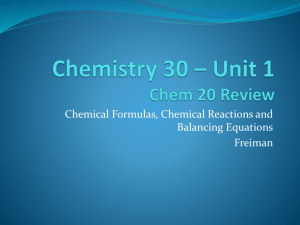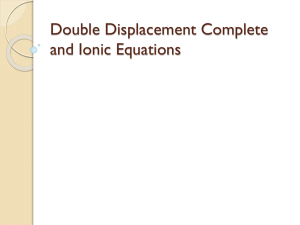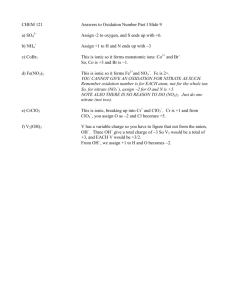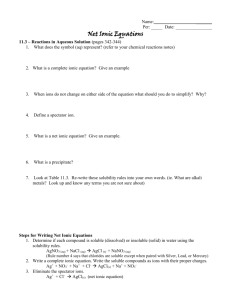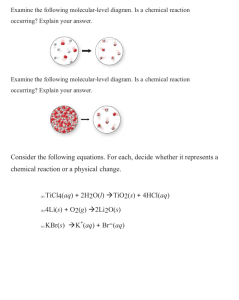Reactions in Aqueous Solutions
advertisement
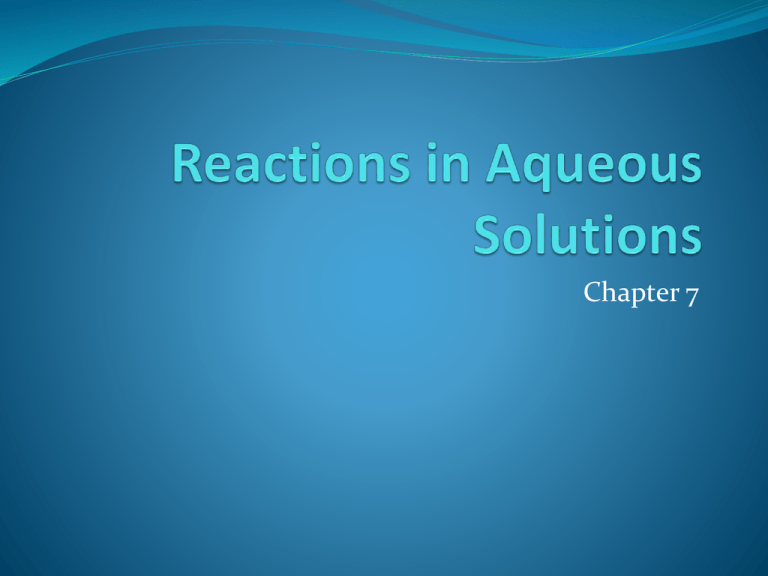
Chapter 7 Driving Forces of Reactions 1. Formation of a solid (precipitation reaction) 2. Formation of water (acid-base reaction) 3. Transfer of electrons (oxidation-reduction reaction) 4. Formation of a gas I. Precipitation reactions Use solubility rules to determine if a solid is formed (p.170) in the following equations KNO3 (aq)+BaCl2(aq)KCl (?) + Ba(NO3)2 (?) Na2SO4(aq)+Pb(NO3)2(aq)NaNO3 (?)+PbSO4(?) KOH(aq)+Fe(NO3)3KNO3(?)+Fe(OH)3(?) Answers KNO3 (aq)+BaCl2(aq)KCl (aq) + Ba(NO3)2 (aq) This reaction will not occur because a solid is not formed Na2SO4(aq)+Pb(NO3)2(aq)NaNO3 (aq)+PbSO4(s) This chemical reaction will occur KOH(aq)+Fe(NO3)3KNO3(aq)+Fe(OH)3(s) This chemical reaction will occur II Formation of Water In an acid base reaction, salt (ionic compounds) and water always form. HCl(aq) + NaOH (aq)HOH (l) + NaCl (aq) acid base water salt This is the molecular equation-represents the complete formulas of the reactants and products However, we can also write an ionic equation-where the electrolytes are represented as ions (solids and liquids are not broken up) H+(aq) +Cl-(aq)+Na+(aq) +OH-(aq)H2O(l) +Na+(aq) +Cl-(aq) We can also write a net ionic equation-take out the spectator ions (those not involved making a solid or liquid) H+(aq)+OH-(aq)H2O(l) *Na+ and Cl- are present on both sides so we take them out of the net ionic equation Practice Write the molecular, ionic, and net ionic equations for the following reaction Aqueous potassium chromate reacts with aqueous barium nitrate Answers Molecular K2CrO4 (aq) + Ba(NO3)2BaCrO4 (s) + 2KNO3(aq) Ionic 2K+1(aq)+CrO4-2 (aq) + Ba+2(aq)+2NO3-1(aq)BaCrO4 (s) + 2K+(aq)+2NO3-1(aq) Net Ionic CrO4-2 (aq) + Ba+2(aq)BaCrO4 (s) III Transfer of electrons Oxidation-loss of electrons Reduction-gain of electrons Oxidation/reduction reaction-metal/nonmetal reaction (sometimes nonmetals undergo ox/red if oxygen is a reactant) 2Na(s)+Cl2(g)2NaCl(s) Na + Cl Na++ Cloxidation reduction IV Formation of a gas 2AlN (s) 2Al (s) + N2 (g)
